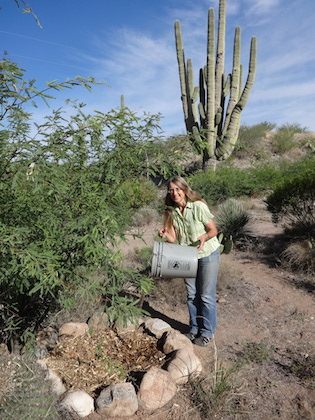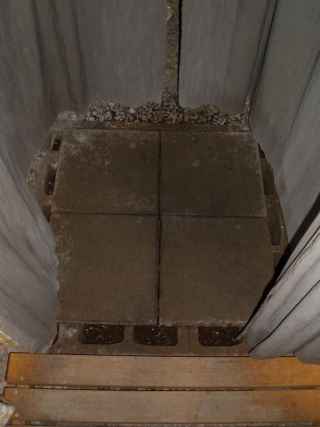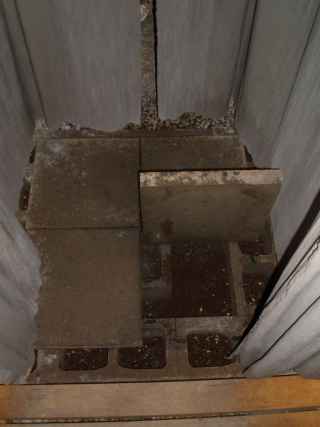(Updated 5/14/2016)
This page describes the graywater/blackwater system we've been using for the past 19 years. This is a companion page to our Water Use webpage. The system is very basic. All wastewater, except that from the shower and laundry, is collected in a 5 gallon bucket and then dumped on a daily basis into mulch basins around trees and shrubs. This is the simplest, most effective system we have found for treating and reusing our wastewater. By emptying wastewater into mulch-filled basins where oxygen is plentiful and microbial activity high, treatment levels for the wastewater are also high. Additionally, research shows that tree roots are quite effective in the uptake of nitrogen, which is a wastewater component and a recognized groundwater contaminant. For these reasons, the water treatment level of this system is probably superior to that of most conventional septic and municipal wastewater systems, despite the simplicity of the method.
This is a convenient system when used in conjunction with the systems described on our Water Use page. This is because the latter encourages radical water conservation, so there's not much wastewater to deal with. There is no drain plumbing anywhere in our wastewater system and nearly all of our water use is outdoors, both in Arizona and in Oregon. For that matter, we have no plumbing of any kind inside either our Arizona or Oregon dwellings. For the past 19 years we have been quite happy with this water use and re-use system and we have no desire for indoor plumbing.
Mulch basins:
Our graywater/blackwater treatment system utilizes 7 mulch basins, 1 for each day of the week. Each basin is located around a tree or bush and is about 5-6 feet in diameter and 10-12 inches deep. The basins are filled with mulch such as shredded leaves or wood chips. For convenience, the basins are located no more than about 25 feet from the water use area. In Arizona, the wastewater is absorbed by the roots of mesquite trees, thus helping to provide us with shade, firewood and edible pods. In Oregon, the graywater irrigates blackberries and blueberries.
With our 15 gallon per day graywater/blackwater output, 7 mulch basins are ample to prevent soil plugging or anaerobic conditions. Wastewater is dumped into a different basin each day to allow time for insects, worms, bacteria, fungi and other agents of decomposition to break down the organic solids, oils, grease and soap. This system has worked well in all seasons and in silty as well as heavy clay soil.
 Emptying graywater bucket into mulch basin beside mesquite tree in Arizona. |
Kitchen "black" water:
In both Arizona and Oregon, our dishes are washed outdoors in dish pans on a table as described on our Water Use page. The waste water is then dumped into a 5 gallon bucket dedicated to that use and is immediately emptied into mulch basins as described above.
Of all residential wastewater, that from the kitchen sink is typically the most problematic to reuse because it is relatively high in organic solids, oils, grease and soap which over time tend to seal up soil pores, preventing water from infiltrating the soil and resulting in a puddle of gray, smelly, anaerobic and potentially pathogenic water. For these reasons, most U.S. jurisdictions classify kitchen wastewater as blackwater. "Graywater" refers to wastewater from other sources such as shower, bathroom sink and washing machine.
Our simple mulch basin method described above works well even for kitchen blackwater because the amount of wastewater we produce is small and because it's distributed to a different mulch basin each day, allowing time for soil organisms to process the impurities.
Shower graywater:
Our shower in Arizona is outdoors and the one we use in Oregon is semi-outdoors. In both, water for showering is supplied from an elevated 5 gallon bucket equipped with a flexible hose, spray nozzle and valve as described on our Water Use page. In Arizona the shower floor is slatted boards and in Oregon is 16 inch square concrete patio blocks..
The Oregon shower floor is located on top of 8x8x16 inch concrete blocks buried in the ground with the tops even with the soil surface. The blocks are installed with the cores vertical and the cores are filled with compost. The function of the blocks is to provide a sturdy base for the shower floor and to contain the compost. The function of the compost is to promote good drainage by filtering out soap, hair and other impurities before they reach the native soil. In use, shower wastewater passes through the slatted floor or between the patio blocks and then through the compost and into the native soil. To prevent the compost from eventually plugging with soap scum, etc., it is replaced once or twice each year. As with our Arizona mulch basin system, this one works well because of the limited amount of water that needs to be processed.
| Oregon shower floor
| Oregon shower floor with patio block raised to show concrete blocks filled with compost |
Laundry graywater: We continue to use the laundry system described on our Water Use page in which the laundry tub is emptied into a mulch basin below the shower/laundry stand.
Wastewater quantities: These figures are our year-round averages for 2 people. Our water use is about the same whether we're in Arizona or Oregon:
-washing dishes - 4 gallons per day
-cooking, drinking and meal preparation - 2 gallons per day
-shaving, face washing, brushing teeth - 1 gallon per day
-showering - 3 gallons per day
-hand
washing - 2 gallons per day
-laundry
- (21 gallons per week) 3 gallons per day
Our total average daily water use for 2 people = 15 gallons

